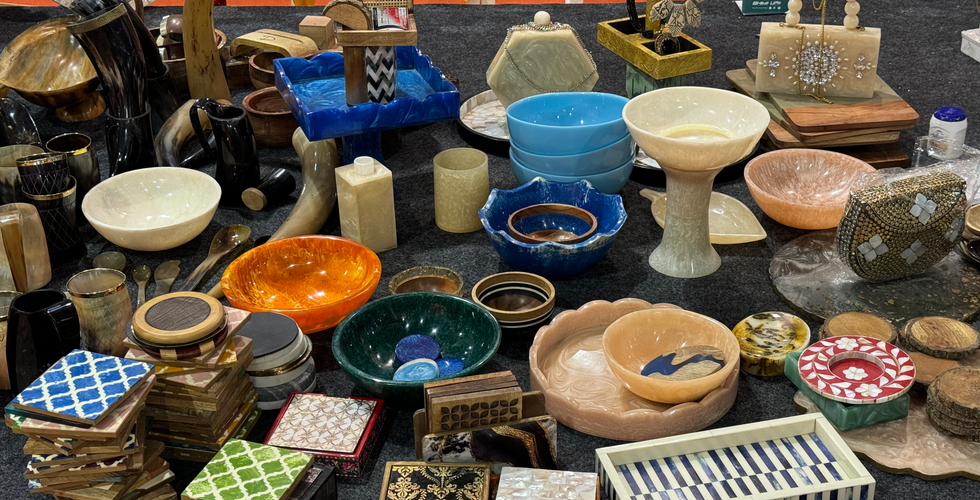UNESCO'S 46th SESSION OF THE WORLD HERITAGE COMMITTEE MEETING
- Amrapali Magazine

- Aug 8, 2024
- 4 min read

The 46th session of the World Heritage Committee convened in New Delhi, India from July 21st to 31st, 2024. This gathering united representatives from various nations to engage in dialogues and partnerships aimed at safeguarding our collective cultural, natural, and mixed heritage. The conference marked a pivotal milestone in promoting international collaboration and safeguarding the integrity of our World Heritage sites.
The World Heritage Committee is composed of delegates from 21 States Parties to the World Heritage Convention (1972) who are appointed by the General Assembly of UNESCO.
The current members of the World Heritage Committee, as of the elections during the 24th General Assembly of UNESCO in November 2023, include the following countries: Argentina, Belgium, Bulgaria, Greece, India, Italy, Jamaica, Japan, Kazakhstan, Kenya, Lebanon, Mexico, Qatar, Republic of Korea, Rwanda, Saint Vincent and the Grenadines, Senegal, Turkey, Ukraine, Vietnam, and Zambia.
The concept of establishing a global initiative to safeguard heritage arose in the aftermath of World War I. The inception of the 1972 Convention concerning the Protection of the World Cultural and Natural Heritage resulted from the amalgamation of two distinct movements: one dedicated to safeguarding cultural sites and the other committed to the preservation of natural environments.
The 46th session of the World Heritage Committee, marked a pivotal moment in global heritage conservation efforts. The Ministry of Culture (MoC), Government of India and its attached office, the Archaeological Survey of India (ASI) are the nodal agencies to host the session this year. The entire exhibit organised in Hall 14 of Pragati Maidan, New Delhi was a grand display of the rich heritages, craft and handloom display from various parts of India.
The session featured a comprehensive agenda that delved into various critical issues. It encompassed the review of reports from the previous session and the World Heritage Centre. The committee engaged in discussions regarding the state of conservation of World Heritage properties, with a particular focus on those listed as World Heritage in Danger. Noteworthy attention was given to capacity-building initiatives and the advancements made by World Heritage-related Category 2 centers. The nomination procedures for new World Heritage sites were scrutinized, along with updates to the World Heritage List. Additionally, the session addressed the progress of the Third Cycle of Periodic Reporting and the evaluation of international assistance. Financial matters, including the presentation of final accounts and budget execution reports, were thoroughly examined. Furthermore, the agenda encompassed the election of the Chairperson and other officials for the upcoming session, culminating in the adoption of decisions.
This session underscores the enduring dedication to preserving invaluable treasures for future generations. Through fostering global cooperation and upholding the tenets of the World Heritage Convention, the Committee remains instrumental in ensuring the resilience and prosperity of the world's most significant sites amidst contemporary challenges.
THE BUREAU OF THE WORLD HERITAGE COMMITTEE:
The Bureau comprises seven States Parties selected each year by the Committee, including a Chairperson, five Vice-Chairpersons, and a Rapporteur. Responsible for overseeing the Committee's activities, the Bureau determines meeting schedules and agendas. The appointment of the incoming Bureau members is scheduled to occur at the conclusion of the upcoming session of the World Heritage Committee.
ESSENTIAL FUNCTIONS OF THE COMMITTEE ARE:
The primary objectives are to identify cultural and natural properties of Outstanding Universal Value, as nominated by States Parties, for protection under the Convention and to include them in the World Heritage List.
Additionally, the responsibilities include monitoring the conservation status of properties listed in the World Heritage List in collaboration with States Parties. This entails determining which properties should be added to or removed from the List of World Heritage in Danger, as well as deciding on potential deletions from the World Heritage List.
Furthermore, the examination of requests for International Assistance funded by the World Heritage Fund is also part of the mandate.
WORLD HERITAGE CONVENTION:
The Committee is tasked with overseeing the implementation of the World Heritage Convention, which governs the utilisation of the World Heritage Fund and the distribution of financial aid upon requests from States Parties. It holds the ultimate authority in determining whether a property qualifies for inclusion on the World Heritage List. The Committee reviews reports on the conservation status of listed properties and urges States Parties to address any mismanagement issues promptly. Additionally, it makes decisions regarding the inclusion or removal of properties from the List of World Heritage in Danger. By ratifying the Convention, each nation commits to safeguarding not only the World Heritage sites within its borders but also protecting its domestic heritage. States Parties are urged to incorporate the preservation of cultural and natural heritage into regional planning initiatives, establish dedicated personnel and services at heritage sites, conduct scientific and technical conservation research, and implement measures that integrate heritage into the daily life of communities. Furthermore, the Convention mandates that States Parties regularly update the World Heritage Committee on the conservation status of their World Heritage sites. These reports play a vital role in the Committee's operations by facilitating site assessments, identifying specific program requirements, and addressing recurring challenges. States Parties are also encouraged to promote public appreciation for World Heritage sites and bolster their protection through educational and informational campaigns.
.png)

























Comments